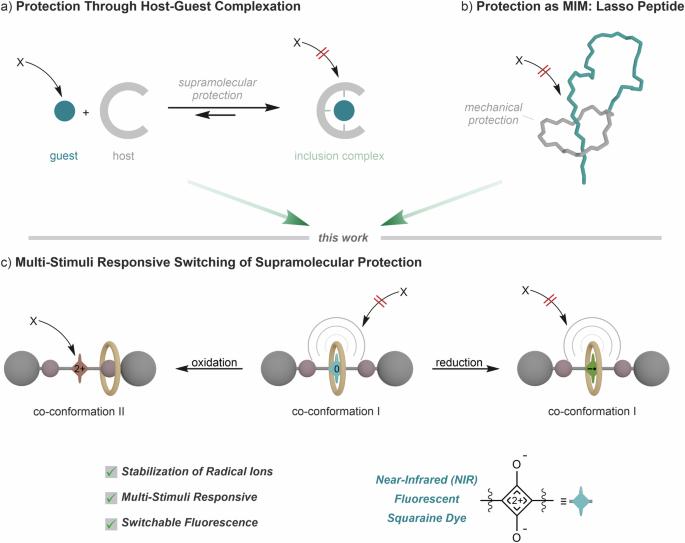在氧化还原活性轮烷中对敏感的鳞烷染料进行可切换的保护和暴露。
IF 5.9
2区 化学
Q1 CHEMISTRY, MULTIDISCIPLINARY
引用次数: 0
摘要
在自然界中,蛋白质中的分子环境可以通过非共价相互作用对有机自由基等活性物质进行立体保护和稳定。在这里,我们报告了一种近红外荧光轮烷,通过四内酰胺大环的配位,可以用化学和电化学方法控制化学性质易变的眯氨酸荧光团的稳定。轮烷可以在两种共构型之间切换,在这两种共构型中,轮烷可以稳定或暴露荧光团。轮的配位影响了角鲨烷在四种氧化还原状态下的稳定性,并使自由基阴离子的稳定性显著提高,比没有机械键合轮保护时提高了 6.7 倍。此外,氧化还原反应还可以逐步调整荧光特性。在受外部刺激控制的共构型转换过程中,机械互锁分子为稳定和选择性暴露活性物种提供了一个极好的支架。本文章由计算机程序翻译,如有差异,请以英文原文为准。

Switchable protection and exposure of a sensitive squaraine dye within a redox active rotaxane
In nature, molecular environments in proteins can sterically protect and stabilize reactive species such as organic radicals through non-covalent interactions. Here, we report a near-infrared fluorescent rotaxane in which the stabilization of a chemically labile squaraine fluorophore by the coordination of a tetralactam macrocycle can be controlled chemically and electrochemically. The rotaxane can be switched between two co-conformations in which the wheel either stabilizes or exposes the fluorophore. Coordination by the wheel affects the squaraine’s stability across four redox states and renders the radical anion significantly more stable—by a factor of 6.7—than without protection by a mechanically bonded wheel. Furthermore, the fluorescence properties can be tuned by the redox reactions in a stepwise manner. Mechanically interlocked molecules provide an excellent scaffold to stabilize and selectively expose reactive species in a co-conformational switching process controlled by external stimuli. Incorporating sensitive chromophores into interlocked systems that are mechanically responsive to external stimuli is attractive for tuning of the dye’s optical properties and stability. Here, the authors report the mechanically controlled protection and deprotection of a squaraine dye within a [2]rotaxane, governed by macrocycle shielding/de-shielding upon chloride addition or oxidation.
求助全文
通过发布文献求助,成功后即可免费获取论文全文。
去求助
来源期刊

Communications Chemistry
Chemistry-General Chemistry
CiteScore
7.70
自引率
1.70%
发文量
146
审稿时长
13 weeks
期刊介绍:
Communications Chemistry is an open access journal from Nature Research publishing high-quality research, reviews and commentary in all areas of the chemical sciences. Research papers published by the journal represent significant advances bringing new chemical insight to a specialized area of research. We also aim to provide a community forum for issues of importance to all chemists, regardless of sub-discipline.
 求助内容:
求助内容: 应助结果提醒方式:
应助结果提醒方式:


